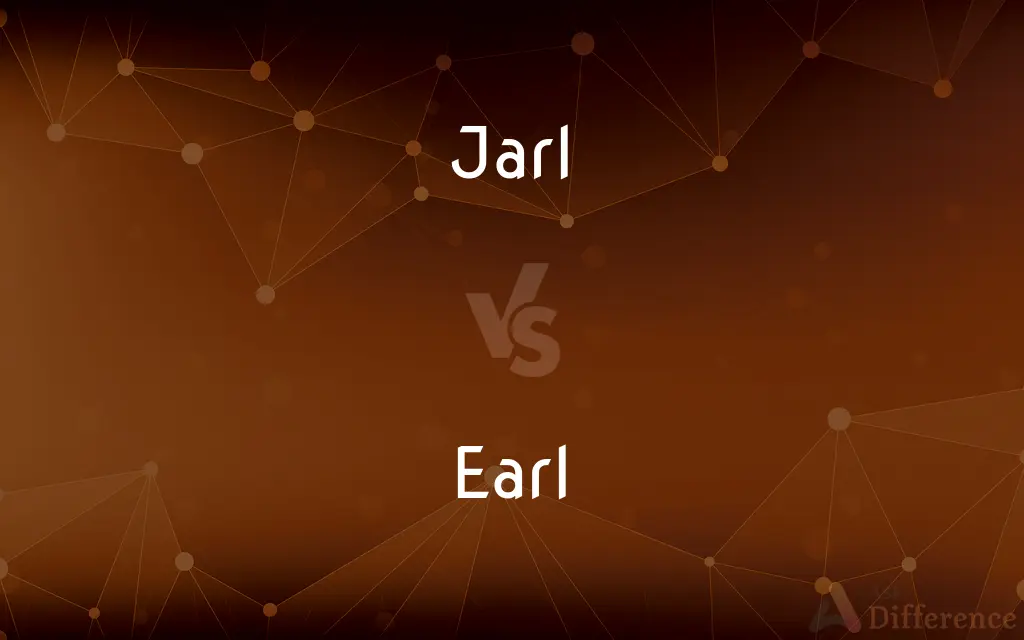Jarl vs. Earl — What's the Difference?
By Fiza Rafique & Urooj Arif — Updated on April 2, 2024
Jarl was a title in Norse societies signifying a chieftain or noble, while Earl is an English title for a member of the nobility, reflecting a similar social rank but under a different cultural context.

Difference Between Jarl and Earl
Table of Contents
ADVERTISEMENT
Key Differences
Jarl, originating from Norse and Viking societies, denoted a high-ranking nobleman, often ruling over territories with considerable autonomy, whereas Earl, a title found within the British peerage system, signifies a rank of nobility below Marquess and above Viscount. While both titles imply nobility and governance, their usage and historical contexts vary significantly, with "Jarl" being used in Scandinavia before the integration of Norse culture into the British Isles, where the term evolved into "Earl."
The role of a Jarl included military leadership, justice administration, and regional governance, reflecting their significant influence in Norse society. On the other hand, an Earl in medieval England had similar responsibilities but operated within a more structured feudal system, where allegiance to the monarch was paramount. This distinction highlights the differences in political structures between Norse societies and feudal England.
In terms of land and wealth, Jarls typically controlled vast territories and had significant economic power, derived from their control over trade routes and resources. In contrast, the wealth of an Earl was also substantial but was more formally recognized and regulated within the feudal system, with lands granted by the king for loyalty and service.
The title of Jarl is imbued with the rich heritage of Viking explorations, raids, and governance, symbolizing a connection to the sea and martial prowess. Meanwhile, the title of Earl carries the historical legacy of the English nobility, often associated with chivalry, feudal duties, and the governance of English shires.
The transition from Jarl to Earl in the British Isles encapsulates the blending of Norse and Anglo-Saxon cultures, especially following the Viking invasions and settlements. This transition not only reflects a change in terminology but also the integration of Norse governance styles and societal structures into the English feudal system.
ADVERTISEMENT
Comparison Chart
Origin
Norse and Viking societies.
British peerage system.
Significance
High-ranking nobleman, often ruling over territories autonomously.
A rank of nobility, below Marquess and above Viscount, with feudal responsibilities.
Responsibilities
Military leadership, justice administration, regional governance.
Similar feudal duties, allegiance to the monarch, governance of regions within a kingdom.
Land and Wealth
Controlled vast territories and resources, economic power from trade.
Substantial wealth, lands granted by the king for loyalty and service.
Cultural Heritage
Associated with Viking heritage, exploration, and martial prowess.
Embodies the historical legacy of English nobility, chivalry, and feudal governance.
Compare with Definitions
Jarl
A title used in Norse societies to denote a high-ranking noble or chieftain.
The Jarl was revered not only as a leader but also as a skilled warrior in his community.
Earl
Originated from the Norse title "Jarl" but evolved within the British feudal system.
Over time, the Norse Jarls in England became known as Earls, integrating into the English nobility.
Jarl
Ruled over territories with significant autonomy, often derived from military prowess.
Jarls maintained their power through control over lands and the loyalty of their warriors.
Earl
Embodies the historical legacy of English nobility and the feudal governance system.
The title of Earl is steeped in the traditions of English chivalry and nobility, with a rich history of governance and duty.
Jarl
Played a key role in Viking explorations and raids, symbolizing martial strength.
Many Jarls led their men in expeditions across the seas, seeking wealth and glory.
Earl
An English noble title, ranking below a Marquess and above a Viscount.
The Earl governed his lands with a duty to maintain peace and order under the king's law.
Jarl
Culturally, represents the rich heritage and traditions of Norse and Viking societies.
The title of Jarl carries with it a legacy of Norse mythology and the era of Viking dominance.
Earl
Wealth and status derived from lands granted by the monarch for loyalty and service.
The king granted extensive lands to his loyal Earls, ensuring their support and service.
Jarl
Their economic power often stemmed from control over trade routes and resources.
The wealth of a Jarl was significantly enhanced by his control over strategic trade routes.
Earl
Responsibilities included governance of regions, military leadership, and justice administration.
An Earl was often tasked with leading military campaigns on behalf of the monarch.
Jarl
A medieval Scandinavian chieftain or nobleman.
Earl
Earl () is a rank of the nobility in Britain. The title originates in the Old English word eorl, meaning "a man of noble birth or rank".
Jarl
(historical) A medieval Scandinavian nobleman, especially in Norway and Denmark.
Earl
A British nobleman next in rank above a viscount and below a marquis, corresponding to a count in continental Europe.
Jarl
A chief; an earl; in English history, one of the leaders in the Danish and Norse invasions.
Earl
Used as a title for such a nobleman.
Earl
(entomology) Any of various nymphalid butterflies of the genus Tanaecia. Other butterflies in this genus are called counts and viscounts.
Earl
A nobleman of England ranking below a marquis, and above a viscount. The rank of an earl corresponds to that of a count (comte) in France, and graf in Germany. Hence the wife of an earl is still called countess. See Count.
Earl
The needlefish.
Earl
A British peer ranking below a Marquess and above a Viscount
Common Curiosities
What distinguishes an Earl's responsibilities?
An Earl had similar feudal duties, including allegiance to the monarch, military leadership, and regional governance.
How does the title of Earl fit within the British nobility system?
Earl is a title within the British peerage, ranking below a Marquess and above a Viscount.
How did Jarls acquire their wealth and power?
Jarls controlled vast territories and resources, with their wealth often derived from trade and military prowess.
What is the origin of the title "Jarl"?
The title "Jarl" originates from Norse and Viking societies, signifying a high-ranking nobleman.
What were the primary responsibilities of a Jarl?
Jarls were responsible for military leadership, justice administration, and governance of their territories.
Can the cultural heritage of Jarls and Earls be compared?
Yes, Jarls are associated with Viking heritage, while Earls embody the historical legacy of the English nobility.
What role did Jarls play in Viking explorations and raids?
Jarls led expeditions and raids, contributing to the expansion and wealth of Norse societies.
What are the key similarities between Jarls and Earls?
Both titles denote nobility, with responsibilities in military leadership, justice, and governance.
How did the transition from Jarl to Earl occur in the British Isles?
The transition reflects the integration of Norse governance into the English feudal system following Viking settlements.
How does the feudal system influence the role of an Earl?
The feudal system structured the Earl's duties, including land governance, allegiance to the monarch, and military service.
What impact did Norse culture have on the evolution of English nobility titles?
Norse culture significantly influenced the English nobility system, including the transition of Jarls to Earls.
What is the significance of land and wealth for an Earl?
Earls derived their wealth and status from lands granted by the king, reflecting their loyalty and service.
How is the title of Earl perceived in modern British society?
It continues to be a mark of nobility, though its contemporary roles are more ceremonial than feudal.
Are there any historical figures notable for being Jarls or Earls?
Yes, figures such as Rollo, the first Duke of Normandy, originally a Viking Jarl, and numerous historical Earls have played pivotal roles in European history.
What distinguishes the cultural significance of the title "Jarl" in Norse history?
The title embodies Norse martial prowess, exploration, and the Viking era's dominance.
Share Your Discovery

Previous Comparison
Autolysis vs. Autophagy
Next Comparison
Experience vs. ExperimentAuthor Spotlight
Written by
Fiza RafiqueFiza Rafique is a skilled content writer at AskDifference.com, where she meticulously refines and enhances written pieces. Drawing from her vast editorial expertise, Fiza ensures clarity, accuracy, and precision in every article. Passionate about language, she continually seeks to elevate the quality of content for readers worldwide.
Co-written by
Urooj ArifUrooj is a skilled content writer at Ask Difference, known for her exceptional ability to simplify complex topics into engaging and informative content. With a passion for research and a flair for clear, concise writing, she consistently delivers articles that resonate with our diverse audience.














































